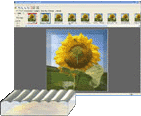2.1 Legend Purpose
Triaxes Legend encodes stereo images to be viewed by a number of various viewing methods. The encoding means “cutting” frames into thin stripes and mixing them in such a way that a pair of stripes is located under each lens: one from the first image and the other from the second one.
Legend generates images for direct printing onto a lenticular lens. 3D images produced with this method can be viewed without special glasses or any additional devices. The program allows you to produce lenticular images with various dynamic effects: flip, motion, morphing, zoom. Besides, you can use the program to create a sequence of frames out of a single source image and a multilayer template. |
|
The software is based on 3DMasterKit, but it is also supplemented with the features necessary for direct printing:
1. Mirroring when encoding.
It is necessary for printing on the flip side of the lens.
2. Positioning frame generation for precise lens positioning on the printing table.
This feature allows to get proper lens positioning on the table. This is one of the key stages of the direct printing process.
3. Partitioning of big images and printing part by part.
An essential feature for printing images bigger than the printing format. The partitioning takes into account the lens pitch.
4. Source frames transparency support, transparency transfer.
Transparency is often used for source frames design. The alpha channel (or transparency) is saved in the encoded image. It allows to encode lenticular images without the background as well and use them for more complex design work.
5. Support of different X-, Y-resolutions.
The general procedure of creating stereo images of any type includes several steps:
● opening the sequence of frames;
● adjusting their relative positions and cropping;
● specifying parameters and generating a stereo image;
● image printing.
The program also allows you to apply various additional design elements (logos, frames,
labels, etc.) onto final encoded images.
